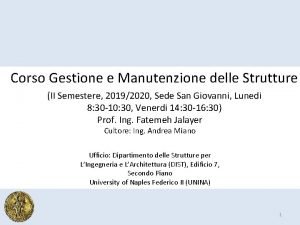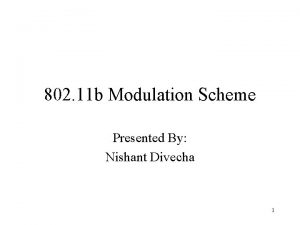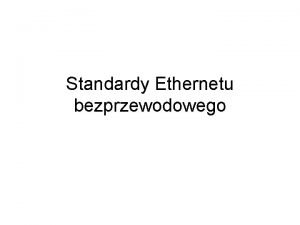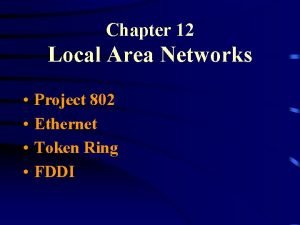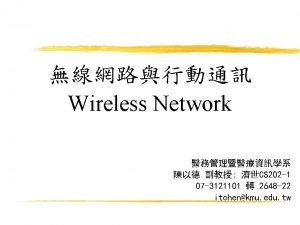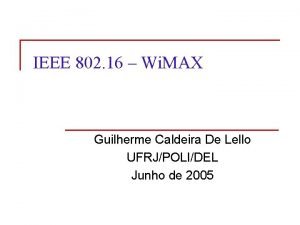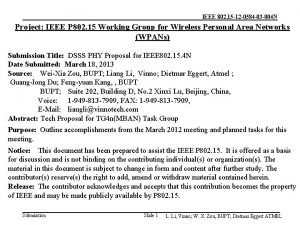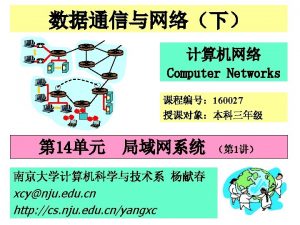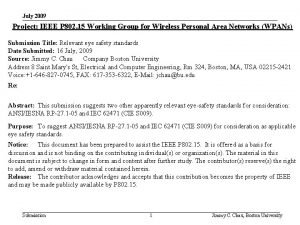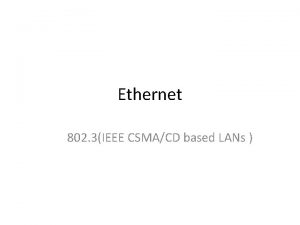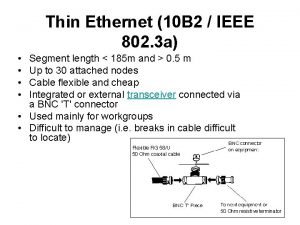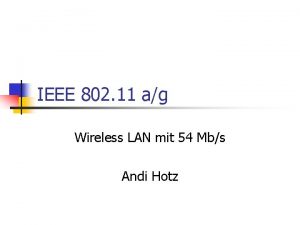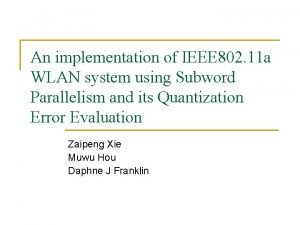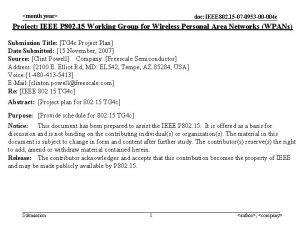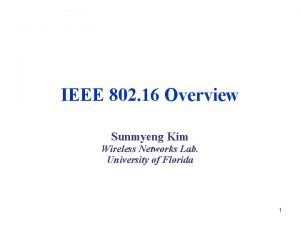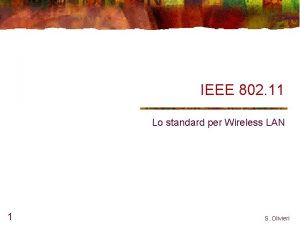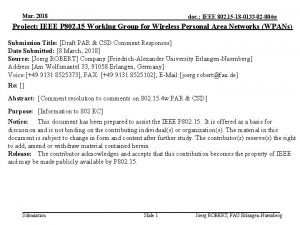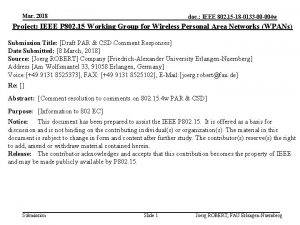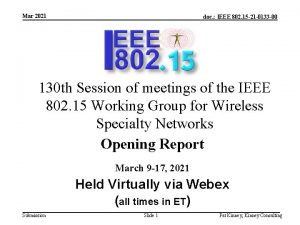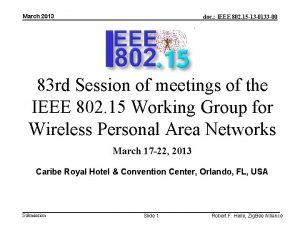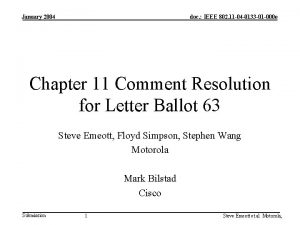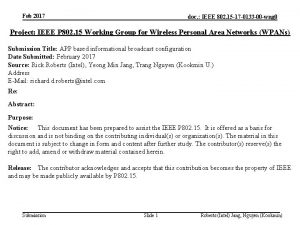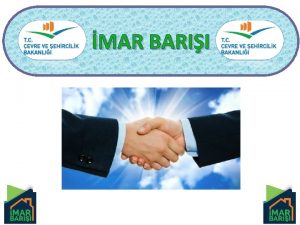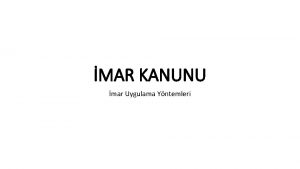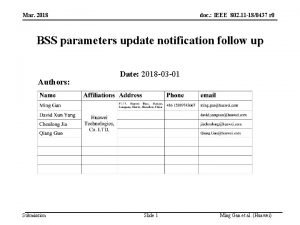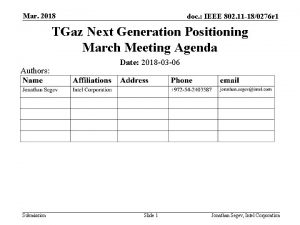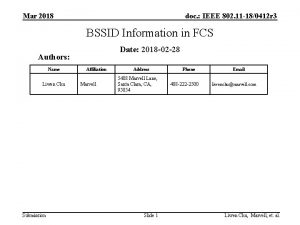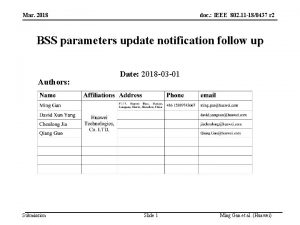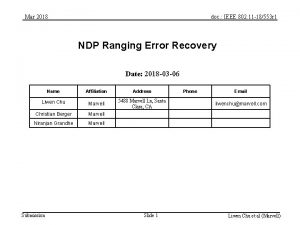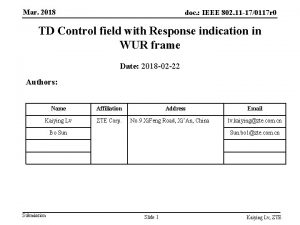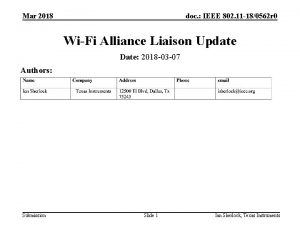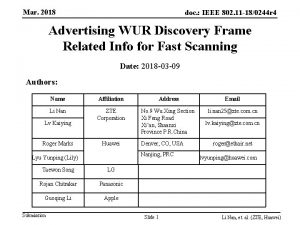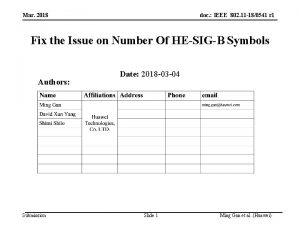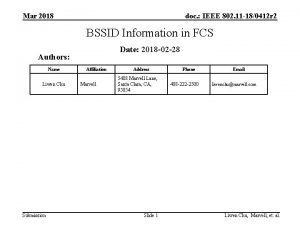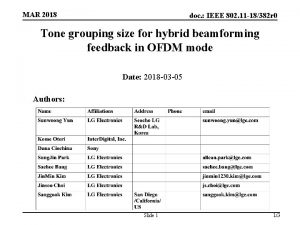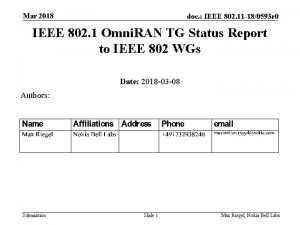Mar 2018 doc IEEE 802 15 18 0133






























- Slides: 30

Mar. 2018 doc. : IEEE 802. 15 -18 -0133 -03 -004 w Project: IEEE P 802. 15 Working Group for Wireless Personal Area Networks (WPANs) Submission Title: [Draft PAR & CSD Comment Responses] Date Submitted: [7 March, 2018] Source: [Joerg ROBERT] Company [Friedrich-Alexander University Erlangen-Nuernberg] Address [Am Wolfsmantel 33, 91058 Erlangen, Germany] Voice: [+49 9131 8525373], FAX: [+49 9131 8525102], E-Mail: [joerg. robert@fau. de] Re: [] Abstract: [Comment resolution to comments on 802. 15. 4 w PAR & CSD after SG 802. 15. 4 w discussions. ] Purpose: [Information to 802 EC] Notice: This document has been prepared to assist the IEEE P 802. 15. It is offered as a basis for discussion and is not binding on the contributing individual(s) or organization(s). The material in this document is subject to change in form and content after further study. The contributor(s) reserve(s) the right to add, amend or withdraw material contained herein. Release: The contributor acknowledges and accepts that this contribution becomes the property of IEEE and may be made publicly available by P 802. 15. Submission Slide 1 Joerg ROBERT, FAU Erlangen-Nuernberg

Mar. 2018 doc. : IEEE 802. 15 -18 -0133 -03 -004 w Draft 802. 15. 4 w PAR & CSD Comment Responses Joerg ROBERT (FAU Erlangen. Nuernberg), chair SG 802. 15. 4 w Submission Slide 2 Joerg Robert, FAU Erlangen-Nuernberg

Mar. 2018 doc. : IEEE 802. 15 -18 -0133 -03 -004 w In response to the comments from James Gilb Submission Slide 3 Joerg Robert, FAU Erlangen-Nuernberg

Mar. 2018 doc. : IEEE 802. 15 -18 -0133 -03 -004 w Comment JG #1: PAR 5. 2 b Comment: Add the anticipated range that this new PHY will provide Text in PAR/CSD: This amendment defines a Low Power Wide Area Network (LPWAN) extension to the IEEE Std. 802. 15. 4 LECIM PHY layer to cover network cell radii of typically 10 -15 km in rural areas. Remarks / Answers to the Comments: Accept: Added text to anticipate the range of typical LPWAN networks. Submission Slide 4 Joerg Robert, FAU Erlangen-Nuernberg

Mar. 2018 doc. : IEEE 802. 15 -18 -0133 -03 -004 w Comment JG #2: PAR 5. 2 b cont’d Comment: Delete "as needed“ Text in PAR/CSD: Modifications to the Medium Access Control (MAC) layer, needed to support this PHY extension, are defined as needed. Remarks / Answers to the Comments: Accept: “as needed” is deleted as suggested. Submission Slide 5 Joerg Robert, FAU Erlangen-Nuernberg

Mar. 2018 doc. : IEEE 802. 15 -18 -0133 -03 -004 w Comment JG #3: PAR 5. 5 Comment: The text says that high link margin is required for interferers, but doesn't put a value on "high". What is high and why don't current PHYs in 802. 15. 4 meet it? Text in PAR/CSD: A main functional requirement for LPWANs is achieving improved link margin of typically 155 d. B - 160 d. B to deal with interferers and achieve distances of typically 10 km - 15 km in rural areas using a low transmit power (typically 14 d. Bm), while maintaining low energy consumption. Remarks / Answers to the Comments: Accept: Figures added to PAR document. Submission Slide 6 Joerg Robert, FAU Erlangen-Nuernberg

Mar. 2018 doc. : IEEE 802. 15 -18 -0133 -03 -004 w Comment JG #4: PAR 5. 5 cont’d Comment: -140 d. Bm sensitivity implies -174 d. Bm/Hz + 10 d. B SNR and NF gives -164 d. Bm/Hz, leaving only 24 d. B for BW, or 251 Hz. That would likely give < 1 kb/s, which doesn't work for Io. T. From where does this -140 d. Bm come? Text in PAR/CSD: Remarks / Answers to the Comments: Revised: We will insert in 8. 1 the following clarification: -140 d. Bm is the typical sensitivity in current Low Power Wide Area Systems. A bit-rate of 1 kb/s is sufficient for many LPWA Io. T applications. Submission Slide 7 Joerg Robert, FAU Erlangen-Nuernberg

Mar. 2018 doc. : IEEE 802. 15 -18 -0133 -03 -004 w Comment JG #5: PAR 5. 5 cont’d Comment: “The end result is the inability to guarantee the required transmission reliability in such scenarios. " Wireless networks can never "guarantee the required transmission reliability" and this project won't change that fact. Text in PAR/CSD: The end result is the inability to guarantee the required transmission reliability in such scenarios. This amendment is needed to close this gap and to provide reliable transmission at receiver sensitivities of -140 d. Bm while delivering multiyear battery life. The end result is the inability to achieve the required transmission reliability in such scenarios. This amendment is needed to close this gap and to provide adequate receiver sensitivities of typically -140 d. Bm while still delivering multiyear battery life. Remarks / Answers to the Comments: Accept: “Guarantee” and “reliable” are removed and text revised. Submission Slide 8 Joerg Robert, FAU Erlangen-Nuernberg

Mar. 2018 doc. : IEEE 802. 15 -18 -0133 -03 -004 w Comment JG #6: PAR 5. 5 cont’d Comment: "receiver sensitivities of -140 d. Bm while delivering multiyear battery life. " 802. 15. 4 already provides multi-year battery life with the existing PHYs. There does not appear to be anything proposed with the amendment that would improve battery life. In fact, by spreading the information over a longer period of time, the receiver would be on longer, using more power, not less. Text in PAR/CSD: Remarks / Answers to the Comments: Accepted: See comment JG #5 for revised text. Submission Slide 9 Joerg Robert, FAU Erlangen-Nuernberg

Mar. 2018 doc. : IEEE 802. 15 -18 -0133 -03 -004 w Comment JG #7: CSD 1. 2. 3 Comment: Quantify "high immunity to interference". Text in PAR/CSD: The proposed project enhances and is limited to the existing 802. 15. 4 LECIM FSK PHY. It uniquely provides a combination of capacities in low data rate, latency tolerant applications not available in any other standard, such as enhanced link margin and long range, while delivering high immunity to interference and still maintaining a multiyear battery life. Remarks / Answers to the Comments: Accept: Text is revised in CSD document. Submission Slide 10 Joerg Robert, FAU Erlangen-Nuernberg

Mar. 2018 doc. : IEEE 802. 15 -18 -0133 -03 -004 w Comment JG #8: CSD 1. 2. 5 Comment: None of the reasons given address why this specific, new addition will be similar in cost to existing 802. 15. 4 devices (which vary widely in cost, depending on which version of 802. 15. 4 you implement). Are there LECIM devices fielded? Text in PAR/CSD: This project can be implemented with no hardware changes and therefore change to the existing device cost basis which has been demonstrated, through billions of shipped devices. Remarks / Answers to the Comments: Accept: Text is modified in the CSD document. Submission Slide 11 Joerg Robert, FAU Erlangen-Nuernberg

Mar. 2018 doc. : IEEE 802. 15 -18 -0133 -03 -004 w Comment JG #9: CSD 1. 2. 5 cont’d Comment: The answer for c) does not address item c), which has to do with installation costs, no manufacturing methods. Text in PAR/CSD: Implementation of this amendment requires no change to current manufacturing methods. This project can be implemented with no hardware changes and therefore to the existing implementation costs which has been demonstrated, through billions of shipped devices. Remarks / Answers to the Comments: Accept: Text is replaced in CSD document. Submission Slide 12 Joerg Robert, FAU Erlangen-Nuernberg

Mar. 2018 doc. : IEEE 802. 15 -18 -0133 -03 -004 w In response to the comments from IEEE 802. 3 Submission Slide 13 Joerg Robert, FAU Erlangen-Nuernberg

Mar. 2018 doc. : IEEE 802. 15 -18 -0133 -03 -004 w Comment 802. 3 #1: PAR 5. 3 Comment: Question is not answered, please do so. Text in PAR/CSD: Is the completion of this standard dependent upon the completion of another standard: No Remarks / Answers to the Comments: Accept: Answer to question is added. Submission Slide 14 Joerg Robert, FAU Erlangen-Nuernberg

Mar. 2018 doc. : IEEE 802. 15 -18 -0133 -03 -004 w Comment 802. 3 #2: PAR 6. 1 b Comment: Not sure who recommended review but if so, the RAC Chair is unaware of a recommendation from the RAC or from editorial staff (typically occurring because of content found in MEC review). RAC review can also be requested by the WG/TG later without a PAR modification if "not anticipated" registry related content appears in the draft. Please refer to the PAR form instructions (copied at end of slide deck) for when a Yes answer is appropriate and consider if the answer should be changed to No. (The RAC has reviewed IEEE Std 802. 15. 4. ) Text in PAR/CSD: 6. 1. b. Is the Sponsor aware of possible registration activity related to this project? : Yes. No If yes please explain: There should be none but a RAC review is recommended Remarks / Answers to the Comments: Accept: Registration activity is not required. Answer is changed to “no”. Submission Slide 15 Joerg Robert, FAU Erlangen-Nuernberg

Mar. 2018 doc. : IEEE 802. 15 -18 -0133 -03 -004 w Comment 802. 3 #3: CSD 1. 2. 5 c Comment: The answer about manufacturing costs is non-responsive to the question about installation costs. Please provide a responsive answer. Text in PAR/CSD: This project can be implemented with no hardware changes and therefore change to the existing device cost basis which has been demonstrated, through billions of shipped devices. Remarks / Answers to the Comments: Accept: Text is modified in the CSD document. (identical to comment JG #8) Submission Slide 16 Joerg Robert, FAU Erlangen-Nuernberg

Mar. 2018 doc. : IEEE 802. 15 -18 -0133 -03 -004 w Comment 802. 3 #4: CSD 1. 2. 5 d Comment: Change IEEE Std. 802. 15. 4 to IEEE Std 802. 15. 4 (remove the dot after Std). Text in PAR/CSD: There already devices using IEEE Std. 802. 15. 4 in volume shipment operating in the same frequency bands and PHY modes. Remarks / Answers to the Comments: Accept: Dot is removed in the revised CSD document. Submission Slide 17 Joerg Robert, FAU Erlangen-Nuernberg

Mar. 2018 doc. : IEEE 802. 15 -18 -0133 -03 -004 w In response to the comments from IEEE 802. 11 Submission Slide 18 Joerg Robert, FAU Erlangen-Nuernberg

Mar. 2018 doc. : IEEE 802. 15 -18 -0133 -03 -004 w Comment 802. 11 #1: PAR 2. 1 Comment: Use of “Low Power” should include a range or limit. Text in PAR/CSD: Remarks / Answers to the Comments: Reject: This is the industry nomenclature for this type of networks. Submission Slide 19 Joerg Robert, FAU Erlangen-Nuernberg

Mar. 2018 doc. : IEEE 802. 15 -18 -0133 -03 -004 w Comment 802. 11 #2: PAR 2. 1 cont’d Comment: expand “LEICM” Text in PAR/CSD: Amendment for a Low Power Wide Area Network (LPWAN) extension to the LECIM (low-energy, critical infrastructure monitoring) Physical layer (PHY). Remarks / Answers to the Comments: Accept: LECIM is expanded. Submission Slide 20 Joerg Robert, FAU Erlangen-Nuernberg

Mar. 2018 doc. : IEEE 802. 15 -18 -0133 -03 -004 w Comment 802. 11 #3: PAR 5. 2 b Comment: editorial remove extra period “Std. ” should be “Std” Text in PAR/CSD: This amendment defines a Low Power Wide Area Network (LPWAN) extension to the IEEE Std. 802. 15. 4 LECIM PHY layer. Remarks / Answers to the Comments: Accept: Text is modified as suggested. Submission Slide 21 Joerg Robert, FAU Erlangen-Nuernberg

Mar. 2018 doc. : IEEE 802. 15 -18 -0133 -03 -004 w Comment 802. 11 #4: PAR 5. 2 b cont’d Comment: correct “<30 k. Bit/s” should “< 30 kb/s” Text in PAR/CSD: It uses the LECIM PHY FSK (Frequency Shift Keying) PHY modulation schemes with extensions to lower bit-rates (e. g. payload bit-rate typically < 30 kb. Bit/s). Remarks / Answers to the Comments: Accept: “<30 k. Bit/s” is changed to “< 30 kb/s” and position of PHY is adjusted Submission Slide 22 Joerg Robert, FAU Erlangen-Nuernberg

Mar. 2018 doc. : IEEE 802. 15 -18 -0133 -03 -004 w Comment 802. 11 #5: PAR 5. 2 b cont’d Comment: expand “FSK” Text in PAR/CSD: It uses the LECIM PHY FSK (Frequency Shift Keying) PHY modulation schemes with extensions to lower bit-rates (e. g. payload bit-rate typically < 30 kb. Bit/s). Remarks / Answers to the Comments: Accept: The term FSK is expanded in the PAR document. The order of FSK and PHY is changed. Submission Slide 23 Joerg Robert, FAU Erlangen-Nuernberg

Mar. 2018 doc. : IEEE 802. 15 -18 -0133 -03 -004 w Comment 802. 11 #6: PAR 5. 2 b cont’d Comment: delete “Furthermore, it defines lower code rates of the FEC in addition to the K=7 R=1/2 convolutional code. Modifications to the Medium Access Control (MAC) layer, needed to support this PHY extension, are defined as needed. ” or at least reword to be definitive and define “lower code rates” and the reword to make meaning of “K=7 R=1/2 convolutional code” clear. Text in PAR/CSD: It defines additional lower code rates of the Forward Error Correction (FEC). Modifications to the Medium Access Control (MAC) layer, needed to support this PHY extension, are defined. Remarks / Answers to the Comments: Accept: It defines additional lower code rates of the Forward Error Correction (FEC). Modifications to the Medium Access Control (MAC) layer, needed to support this PHY extension, are defined. Submission Slide 24 Joerg Robert, FAU Erlangen-Nuernberg

Mar. 2018 doc. : IEEE 802. 15 -18 -0133 -03 -004 w Comment 802. 11 #7: PAR 5. 2 b Comment: define the expected range of “Wide Area Network”. i. e. what are you expecting to reach. Text in PAR/CSD: This amendment defines a Low Power Wide Area Network (LPWAN) extension to the IEEE Std. 802. 15. 4 LECIM PHY layer to cover network cell radii of typically 10 -15 km in rural areas. Remarks / Answers to the Comments: Accept: Added text to anticipate the range of typical LPWAN networks. (identical to comment JG #1) Submission Slide 25 Joerg Robert, FAU Erlangen-Nuernberg

Mar. 2018 doc. : IEEE 802. 15 -18 -0133 -03 -004 w Comment 802. 11 #8: PAR 5. 5 Comment: What is “very high link margin” vs “high link margin”? rewording is expected. Text in PAR/CSD: A main functional requirement for LPWANs is achieving improved link margin of typically 155 d. B - 160 d. B to deal with interferers and achieve distances of typically 10 km - 15 km in rural areas using a low transmit power (typically 14 d. Bm), while maintaining low energy consumption. Remarks / Answers to the Comments: Accept: The word “very” is replaced by improved. Additionally, a commonly accepted link margin range figure (e. g. ETSI, 3 GPP) of 155 d. B – 160 d. B is added. (identical to comment JG #3) Submission Slide 26 Joerg Robert, FAU Erlangen-Nuernberg

Mar. 2018 doc. : IEEE 802. 15 -18 -0133 -03 -004 w Comment 802. 11 #9: PAR 5. 5 cont’d Comment: Please include definition of the expected range and power that is being included in the specification. Text in PAR/CSD: A main functional requirement for LPWANs is achieving improved link margin of typically 155 d. B - 160 d. B to deal with interferers and achieve distances of typically 10 km - 15 km in rural areas using a low transmit power (typically 14 d. Bm), while maintaining low energy consumption. Remarks / Answers to the Comments: Accept: The expected range and the power are added to the PAR document. (identical to comment JG #3) Submission Slide 27 Joerg Robert, FAU Erlangen-Nuernberg

Mar. 2018 doc. : IEEE 802. 15 -18 -0133 -03 -004 w Comment 802. 11 #10: PAR 5. 5 cont’d Comment: “guarantee” reword this sentence as you will not be able to “guarantee” in general. Text in PAR/CSD: Remarks / Answers to the Comments: Accept: The word “guarantee” is removed from the PAR. See identical comment JG #5 for revised text. Submission Slide 28 Joerg Robert, FAU Erlangen-Nuernberg

Mar. 2018 doc. : IEEE 802. 15 -18 -0133 -03 -004 w Comment 802. 11 #12: PAR 5. 6 Comment: delete “and similar organtizations” – not necessary (and misspelled). Text in PAR/CSD: Chip Vendors, Product Manufacturers, Wireless Carriers, Utilities, Cities, Agriculture, Infrastructure/Environmental Monitoring Organizations and similar organtizations. Remarks / Answers to the Comments: Accept: Text is deleted from the PAR document. Submission Slide 29 Joerg Robert, FAU Erlangen-Nuernberg

Mar. 2018 doc. : IEEE 802. 15 -18 -0133 -03 -004 w Comment 802. 11 #13: PAR 8. 1 Comment: Add full name of the cited “IEEE Std 802. 11 h. Text in PAR/CSD: IEEE Std 802. 11 ah, Wireless LAN Medium Access Control (MAC) and Physical Layer (PHY) Specifications, Amendment 2: Sub 1 GHz License Exempt Operation Remarks / Answers to the Comments: Accept: Added full name as requested to the PAR document in section 8. 1. Submission Slide 30 Joerg Robert, FAU Erlangen-Nuernberg
 Bridges from 802.x to 802.y
Bridges from 802.x to 802.y Bridges from 802.x to 802.y
Bridges from 802.x to 802.y Bluetooth ieee 802
Bluetooth ieee 802 802 ieee
802 ieee Ieee 802
Ieee 802 Ieee 802 family
Ieee 802 family Ieee 802 3 compliance
Ieee 802 3 compliance Ieee 802
Ieee 802 Arquitetura ieee 802
Arquitetura ieee 802 El 802
El 802 Ieee 802 standard
Ieee 802 standard Que letra continua m v t m j
Que letra continua m v t m j Esempio piano di manutenzione delle strutture ntc 2018 doc
Esempio piano di manutenzione delle strutture ntc 2018 doc 802 11
802 11 Standardy 802
Standardy 802 802 5
802 5 Project 802 in data communication network
Project 802 in data communication network 802 family
802 family 802 16
802 16 802 15
802 15 802 protocols
802 protocols Ccna 640-802
Ccna 640-802 09 802 0561
09 802 0561 Ethernet 802
Ethernet 802 802-3-ethernet
802-3-ethernet 802 701
802 701 Wireless lan 802
Wireless lan 802 Wlan 802
Wlan 802 802 15
802 15 Ssin-802
Ssin-802 802/11
802/11












